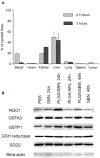Pre-treatment With PLGA/Silibinin Nanoparticles Mitigates Dacarbazine-Induced Hepatotoxicity
- PMID: 32671024
- PMCID: PMC7332747
- DOI: 10.3389/fbioe.2020.00495
Pre-treatment With PLGA/Silibinin Nanoparticles Mitigates Dacarbazine-Induced Hepatotoxicity
Abstract
Drug-induced hepatotoxicity is one of the major barriers limiting application of current pharmaceuticals as well as clinical translation of novel and perspective drugs. In this context, numerous hepatoprotective molecules have been proposed to prevent or mitigate drug-induced hepatotoxicity. To date, silibinin (SBN) is a one the most studied hepatoprotective plant-derived agents for prevention/alleviation of drug-induced liver injury. Hepatoprotective mechanisms of SBN include scavenging of free radicals, upregulation of detoxifying enzymes via Nrf2 activation and inhibition of inflammatory activation of resident macrophages. However, low solubility of this phytochemical in water prevents its intravenous administration and constrains its bioavailability and efficacy. Here, we developed SBN-loaded poly(lactic-co-glycolic) acid (PLGA)-based nanoparticles for intravenous administration aiming at mitigation of drug-induced hepatotoxicity. Obtained nanoparticles demonstrated a slow drug release profile in vitro and caused upregulation of antioxidant and phase II enzymes in AML12 hepatocytes including superoxide dismutase 2, glutathione-S-transferase P1, and glutathione-reductase. Intravenous administration of PLGA nanoparticles to mice led to their fast liver accumulation. In vivo analysis of hepatoprotective effects of PLGA/SBN nanoparticles was carried out on melanoma tumor-bearing syngeneic mouse model treated with the antineoplastic drug dacarbazine (DTIC), which often causes severe hepatotoxicity including development of veno-occlusive disease. It was found that PLGA/SBN caused effective induction of detoxifying liver enzymes. Moreover, pre-treatment with PLGA/SBN nanoparticles reduced elevated transaminase and bilirubin levels in blood, caspase 3 activation, and morphological histology changes in liver tissue upon DTIC treatment. Treatment with PLGA/SBN nanoparticles did not interfere with therapeutic efficacy of DTIC.
Keywords: drug combination; drug-induced liver injury; hepatoprotection; melanoma; nanoformulation.
Copyright © 2020 Durymanov, Permyakova and Reineke.
Figures






Similar articles
-
Zidovudine and isoniazid induced liver toxicity and oxidative stress: Evaluation of mitigating properties of silibinin.Environ Toxicol Pharmacol. 2016 Sep;46:217-226. doi: 10.1016/j.etap.2016.07.014. Epub 2016 Jul 26. Environ Toxicol Pharmacol. 2016. PMID: 27497728
-
Silibinin alleviates N-nitrosodimethylamine-induced glutathione dysregulation and hepatotoxicity in rats.Chin J Nat Med. 2016 Jan;14(1):40-7. doi: 10.3724/SP.J.1009.2016.00040. Chin J Nat Med. 2016. PMID: 26850345
-
Erythrocyte membrane-camouflaged mesoporous silica composite nanoparticles for loading and controlled release of the hepatoprotective agent silibinin: A-synthesis and physicochemical characterization.J Pharm Pharmacol. 2024 Aug 2;76(8):995-1005. doi: 10.1093/jpp/rgae046. J Pharm Pharmacol. 2024. PMID: 38762907
-
Evaluation of ameliorative ability of Silibinin against zidovudine and isoniazid-induced hepatotoxicity and hyperlipidaemia in rats: Role of Silibinin in Phase I and II drug metabolism.Chem Biol Interact. 2017 Aug 1;273:142-153. doi: 10.1016/j.cbi.2017.06.008. Epub 2017 Jun 13. Chem Biol Interact. 2017. PMID: 28619387
-
Curcumin as a hepatoprotective agent against chemotherapy-induced liver injury.Life Sci. 2023 Nov 1;332:122119. doi: 10.1016/j.lfs.2023.122119. Epub 2023 Sep 21. Life Sci. 2023. PMID: 37741319 Review.
Cited by
-
Novel Strategies Enhancing Bioavailability and Therapeutical Potential of Silibinin for Treatment of Liver Disorders.Drug Des Devel Ther. 2024 Oct 19;18:4629-4659. doi: 10.2147/DDDT.S483140. eCollection 2024. Drug Des Devel Ther. 2024. PMID: 39444787 Free PMC article. Review.
-
Effects of Low Molecular Weight Peptides from Red Shrimp (Solenocera crassicornis) Head on Immune Response in Immunosuppressed Mice.Int J Mol Sci. 2023 Jun 18;24(12):10297. doi: 10.3390/ijms241210297. Int J Mol Sci. 2023. PMID: 37373442 Free PMC article.
-
Lactobacillus plantarum ST-III culture supernatant ameliorates alcohol-induced cognitive dysfunction by reducing endoplasmic reticulum stress and oxidative stress.Front Neurosci. 2022 Sep 14;16:976358. doi: 10.3389/fnins.2022.976358. eCollection 2022. Front Neurosci. 2022. PMID: 36188464 Free PMC article.
-
Evaluation of Silybin Nanoparticles against Liver Damage in Murine Schistosomiasis mansoni Infection.Pharmaceutics. 2024 May 4;16(5):618. doi: 10.3390/pharmaceutics16050618. Pharmaceutics. 2024. PMID: 38794280 Free PMC article.
-
Natural anti-cancer products: insights from herbal medicine.Chin Med. 2025 Jun 9;20(1):82. doi: 10.1186/s13020-025-01124-y. Chin Med. 2025. PMID: 40490812 Free PMC article. Review.
References
LinkOut - more resources
Full Text Sources
Research Materials

